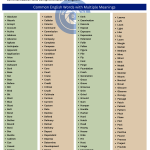Difference Between No and Not
“No” and “not” are both negative words in English, but they are used in different contexts and have different grammatical functions.
No
Part of Speech: “No” can function as a determiner, an adverb, or a noun.
- Determiner: It negates a noun and is placed directly before it.
- Example: “No cars are allowed in the park.”
- Example: “No cars are allowed in the park.”
- Adverb: It can negate an adjective or another adverb.
- Example: “The answer is no longer valid.”
- Example: “The answer is no longer valid.”
- Noun: It can be used as a noun meaning a negative response.
- Example: “She said a firm no.”
Usage in Sentences:
- With Nouns: “No” is used to directly negate a noun without the need for auxiliary verbs.
- Example: “There are no cookies left.”
- Example: “There are no cookies left.”
- As an Answer: “No” can stand alone as a response to a yes/no question.
- Example: “Are you coming?” – “No.”
Not
Part of Speech: “Not” is an adverb that negates verbs, adjectives, adverbs, and noun phrases with auxiliary verbs.
- With Verbs: “Not” is used to negate verbs and is typically placed after auxiliary verbs (be, do, have, will, etc.).
- Example: “I am not going to the party.”
- Example: “I am not going to the party.”
- With Adjectives and Adverbs: “Not” can negate adjectives and adverbs.
- Example: “She is not happy.”
- Example: “She is not happy.”
- With Noun Phrases: “Not” can negate noun phrases when used with auxiliary verbs.
- Example: “This is not a good idea.”
Usage in Sentences:
- With Verbs: “Not” is placed after auxiliary verbs to make a verb phrase negative.
- Example: “She does not like broccoli.”
- Example: “She does not like broccoli.”
- With Adjectives: “Not” is placed before adjectives to make them negative.
- Example: “The movie was not interesting.”
- Example: “The movie was not interesting.”
- With Nouns: “Not” can negate noun phrases when used with auxiliary verbs.
- Example: “That is not my car.”
No vs Not
| No | Not | |
| Definition | A determiner used to negate nouns or noun phrases. | A negative particle used to negate verbs, adjectives, or other adverbs. |
| Used Before | Nouns (without articles), gerunds, and in responses. | Verbs, adjectives, and adverbs. |
| Part of Speech | Determiner, adverb, noun | Adverb |
| Usage with Nouns | Used directly before a noun to negate it | Used with a verb to negate it |
| Usage with Verbs | Cannot be used directly with a verb | Used directly before a verb to make it negative |
| Usage in Answers | Used as a complete negative response to a question | Not used as a standalone response |
| Examples | – There is no bread left. – No smoking allowed. | – She is not coming. – The idea is not good. |
| Short Responses | Used alone to answer questions negatively. | Not typically used alone in responses. |
| Emphasis | Often used for emphasis in exclamations and strong negatives. | Generally used in more standard negation forms. |
| Special Cases | Can indicate a complete absence or non-existence. | Used with auxiliary verbs to negate an action or state. |
| Common Mistakes | Incorrectly used with articles: “no a bread” (Incorrect). | Incorrect placement: “I not like coffee” (Incorrect). |
Common Mistakes
Mistake: I no like coffee.
Correction: I do not like coffee.
Mistake: There is no a book on the table.
Correction: There is no book on the table.
Mistake: Do you want to go? Not.
Correction: Do you want to go? No.
Mistake: This is no good idea.
Correction: This is not a good idea.
Mistake: She is no taller than him.
Correction: She is not taller than him.
Mistake: There is no any reason to worry.
Correction: There is no reason to worry.
Mistake: Not smoking in this area!
Correction: No smoking in this area!
Mistake: He is no always late.
Correction: He is not always late.
Mistake: There are not apples left.
Correction: There are no apples left.
Mistake: This is not the place for no mistakes.
Correction: This is not the place for mistakes.
Understanding the correct usage of “no” and “not” is essential for clear and accurate communication in English. By recognizing their distinct roles and functions, one can avoid common grammatical errors and convey negative statements effectively.
Download Word Coach Application




